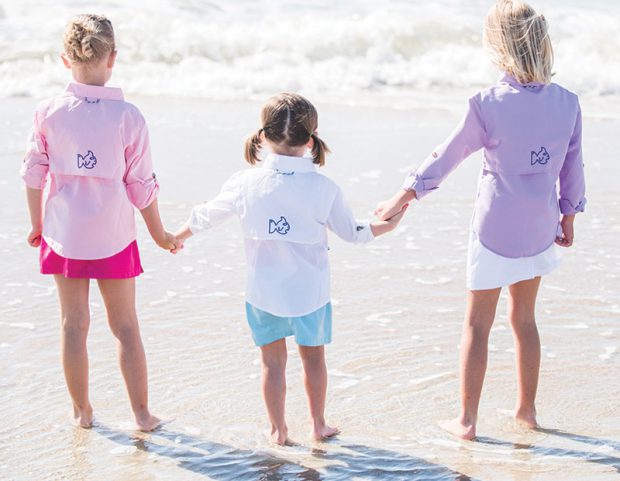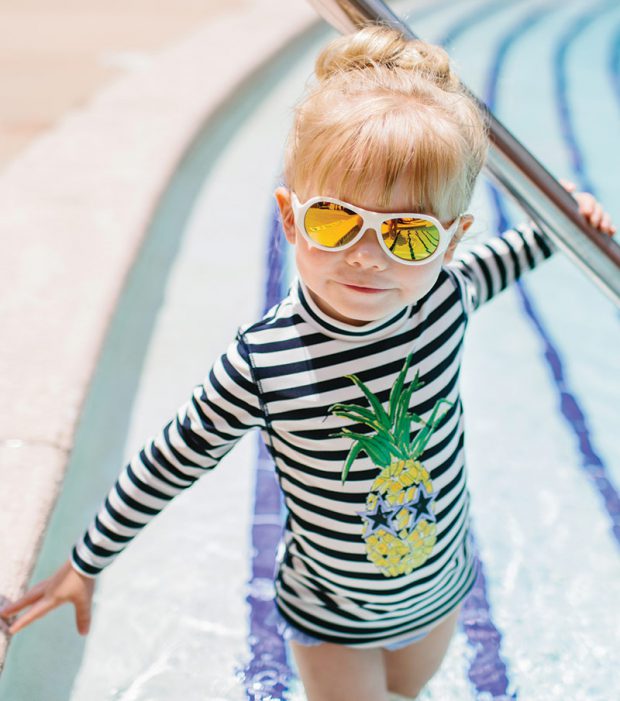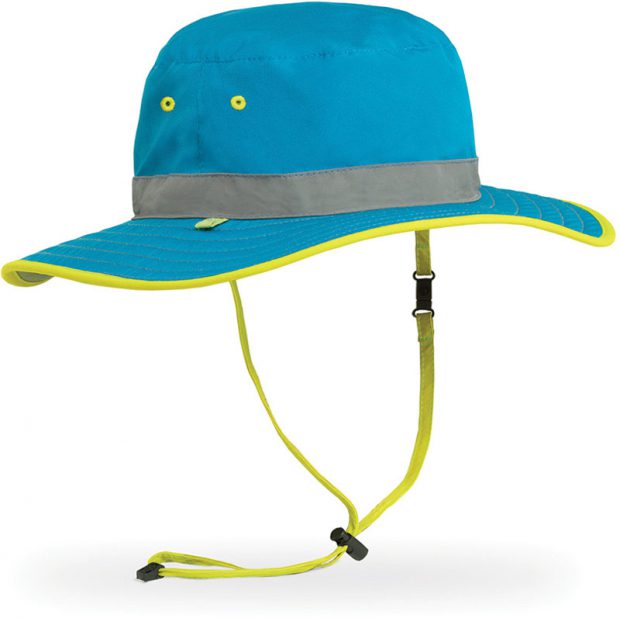Future demand for sun-protective clothing and accessories looks bright.

Prodoh
It’s associated with one of the scariest words out there: cancer. Its effects are cumulative and much of the damage can happen before a child turns 18 years old. It’s the sun. And parents’ desire to keep their children safe while playing outdoors is giving rise to a growing category, sun-protective clothing and accessories.
According to the Skin Cancer Foundation, about 23 percent of lifetime ultraviolet (UV) radiation from the sun can occur before a child turns 18. And here’s another sobering fact: Over the past three decades, more people have had skin cancer than all other cancers combined.
Sun-Protective Terminology
Ultraviolet Protection Factor (UPF) refers solely to the safeguarding properties of fabric. And there are many techniques to achieving sun-protective textiles, either by dipping, coating or weaving sun-protective threads into the fabric itself. UPF is not to be confused with Sun Protection Factor (SPF), which usually refers to the traits of skincare lotions, sprays or other topical treatments. Protection from the sun’s ultraviolet A (UVA) and Ultraviolet B (UVB) rays are typically present in sunglasses.
Millennial moms, in particular, have grown up aware of the harmful effects of the sun. Add to that reports that some pediatricians do not recommend using sunscreen under the age of two combined with the high cost of child-friendly sunscreen and the market has seen the demand for sun-protective clothing climb.
“Sun-protective clothing is an emerging and growing category for the last 10 to 15 years in the U.S.,” says Adheer Bahulkar, a partner in the retail practice of global strategy and management consulting firm A.T. Kearney. “This category really originated in the late ’80s and ’90s in the Australia/New Zealand market and was brought to the U.S. by some of those brands. Australians spend five times more on sun-protective clothing than they do on sunscreen. The U.S. sunscreen market is more than $1 billion, and if you believe the same opportunity exists, then one can surmise the potential is eventually in the range of $5 to $10 billion.”
“We have seen strong and steady growth over the last several years in our line of sun-protective clothing,” confirms L.L. Bean spokesperson Mac McKeever. The Freeport, Maine, brand produces a number of UPF 50+ products, including T-shirts and swim shorts for boys and leggings and surf shirts for girls. “Our outerwear and apparel has always helped protect folks from the elements, be it cold, rain, snow or wind as well as the sun’s damaging rays,” he says.
Manufacturers say the growth in kidswear, in particular, has been palpable. Meadow Lacy, executive vice president of sales and marketing at Ashland, Ore.-based Sunday Afternoons, says the demand for kid’s sun-protective clothing has been the fastest-growing segment of the 25-year-old business for the last two years. “It’s the brightest business to be in at the moment,” he says.
And there are more and more childrenswear manufacturers getting into the sun-protective game. Shade Critters, based in Palm Beach, Fla., was born out of necessity a year ago when Fred Schmidt and his wife Maureen couldn’t find sun-protective clothing that their daughter wanted wear. Now, one year later the line of UPF 50+ swimwear and clothing—even tutus—for sizes 6 months to 14 years is carried in 700 doors with “strong” sell-throughs, says Fred. “I tell my stores, it’s the only thing in the stores that the doctor told them they need to buy,” he says. “There’s a demand driven by necessity.”

Babiators
DJ Doherty and Evan Proffitt, two avid fishermen from Greenville, S.C., had a mission to get their kids outdoors but couldn’t find fishing shirts with sun-protective properties. They ended up launching Prodoh (a mashup of their last names) in 2012 which produces UPF 50+ and UPF 20+ clothing. Proffitts’ wife, Mell, now runs the day-to-day operations with Doherty’s wife, Stacey. “As far as the general public, the scare of the sun has made people aware and sales have picked up speed recently,” says Stacey. “We hear from parents that they love our stuff because the kids are out in the water all day and they’re keeping them safe.” In four short years, Prodoh has grown from sun-protective fishing shirts for boys and girls to a collection featuring gingham tie dresses, boys’ and girls’ swimwear, hats, belts, shorts and T-shirts. The line is now in 300 specialty stores.
While the demand is there, it is also true that there are extra layers to the sun-protective clothing business. Research is a key focus, and many executives say it has been a learning curve working with protective fabric. Increasing the level of protection, for example, can introduce unwanted fabric behaviors such as wrinkling or lack of breathability. The most common level of protection in clothing is UPF 50+, or the highest level a textile can have and still behave like a non-protective fabric. And in order for a company to claim a certain protection level, samples must be tested by an independent third party. “We send it off to our lab in North Carolina,” says Stacey. “They have scientific formulas beyond anything I could explain. Let’s just say you don’t get your samples back. They put it through the paces.”
“When we first launched, we got a lot of ‘Huh?’” explains Molly Fienning, who co-founded sun-protective baby sunglasses line Babiators in 2011. Fienning’s husband is a Marine Corps fighter pilot, and the idea was born on a military base where she saw her fellow military wives’ kids squinting in the sun while their pilot moms and dads stood protected in their stylish aviators. Now, Babiators is carried in 3,000 stores in 45 countries. “Within the last year or two we’ve seen an increase in interest,” she says. “Parents slather their kids with sunscreen but the eyes are just as susceptible. A big part of this is educating them.”
Fienning works closely with The Vision Council keeping tabs on medical facts and current statistics which she then relays back to retailers and customers. “It’s a learning process for us,” she adds. “All this research is so new. Think about what we knew about tobacco a generation ago.”
When Rhonda Sparks lost her husband to melanoma 15 years ago, she started UV Skins to educate people. “It’s not a trend for us,” says the self-proclaimed UV team captain, noting the Sonora, Calif.,-based company always accompanies product with some form of education such as brochures. “It’s definitely our mission to raise awareness.”

Sunday Afternoons
Christie Naegele, director of marketing for Coolibar, also works closely with the medical field. She says the brand is present at the American Academy of Dermatology’s annual meeting every year and regularly collects information from the Skin Cancer Foundation. “We do rigorous testing on-site and off-site,” she says, noting that while the brand is based in Minneapolis, it was originally born in Australia. “We hold ourselves up to the Australian standards and we guarantee our products up to 50 washes.”
While the benefits are clear, sun-protective clothing may be attractive to moms simply for its ease of use. “We call [Coolibar] the effortless sunscreen,” says Naegele. “Kids just want to be out there and play and why chase the kid all over the place trying to put sunscreen on them? Why have the fight?”
As Lacy puts it: “It’s all about having fun outside.”



Leave a Comment: